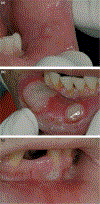The Oral HIV/AIDS Research Alliance: updated case definitions of oral disease endpoints
- PMID: 19594839
- PMCID: PMC10431909
- DOI: 10.1111/j.1600-0714.2009.00749.x
The Oral HIV/AIDS Research Alliance: updated case definitions of oral disease endpoints
Abstract
The Oral HIV/AIDS Research Alliance (OHARA) is part of the AIDS Clinical Trials Group (ACTG), the largest HIV clinical trials organization in the world. Its main objective is to investigate oral complications associated with HIV/AIDS as the epidemic is evolving, in particular, the effects of antiretrovirals on oral mucosal lesion development and associated fungal and viral pathogens. The OHARA infrastructure comprises: the Epidemiologic Research Unit (at the University of California San Francisco), the Medical Mycology Unit (at Case Western Reserve University) and the Virology/Specimen Banking Unit (at the University of North Carolina). The team includes dentists, physicians, virologists, mycologists, immunologists, epidemiologists and statisticians. Observational studies and clinical trials are being implemented at ACTG-affiliated sites in the US and resource-poor countries. Many studies have shared end-points, which include oral diseases known to be associated with HIV/AIDS measured by trained and calibrated ACTG study nurses. In preparation for future protocols, we have updated existing diagnostic criteria of the oral manifestations of HIV published in 1992 and 1993. The proposed case definitions are designed to be used in large-scale epidemiologic studies and clinical trials, in both US and resource-poor settings, where diagnoses may be made by non-dental healthcare providers. The objective of this article is to present updated case definitions for HIV-related oral diseases that will be used to measure standardized clinical end-points in OHARA studies, and that can be used by any investigator outside of OHARA/ACTG conducting clinical research that pertains to these end-points.
Figures






References
-
- Feigal DW, Katz MH, Greenspan D, et al. The prevalence of oral lesions in HIV-infected homosexual and bisexual men: three San Francisco epidemiological cohorts. AIDS 1991;5:519–25. - PubMed
-
- Katz MH, Greenspan D, Westenhouse J, et al. Progression to AIDS in HIV-infected homosexual and bisexual men with hairy leukoplakia and oral candidiasis. AIDS 1992;6:95–100. - PubMed
-
- Glick M, Muzyka BC, Lurie D, Salkin LM. Oral manifestations associated with HIV-related disease as markers for immune suppression and AIDS. Oral Surg Oral Med Oral Pathol 1994;77:344–9. - PubMed
-
- Shiboski CH, Hilton JF, Greenspan D, et al. HIV-related oral manifestations in two cohorts of women in San Francisco. J Acquir Immune Defic Syndr 1994;7:964–71. - PubMed
-
- Shiboski CH, Hilton JF, Neuhaus JM, Canchola A, Greenspan D. Human immunodeficiency virus-related oral manifestations and gender. A longitudinal analysis. Arch Intern Med 1996;156:2249–54. - PubMed
Publication types
MeSH terms
Substances
Grants and funding
LinkOut - more resources
Full Text Sources
Medical

